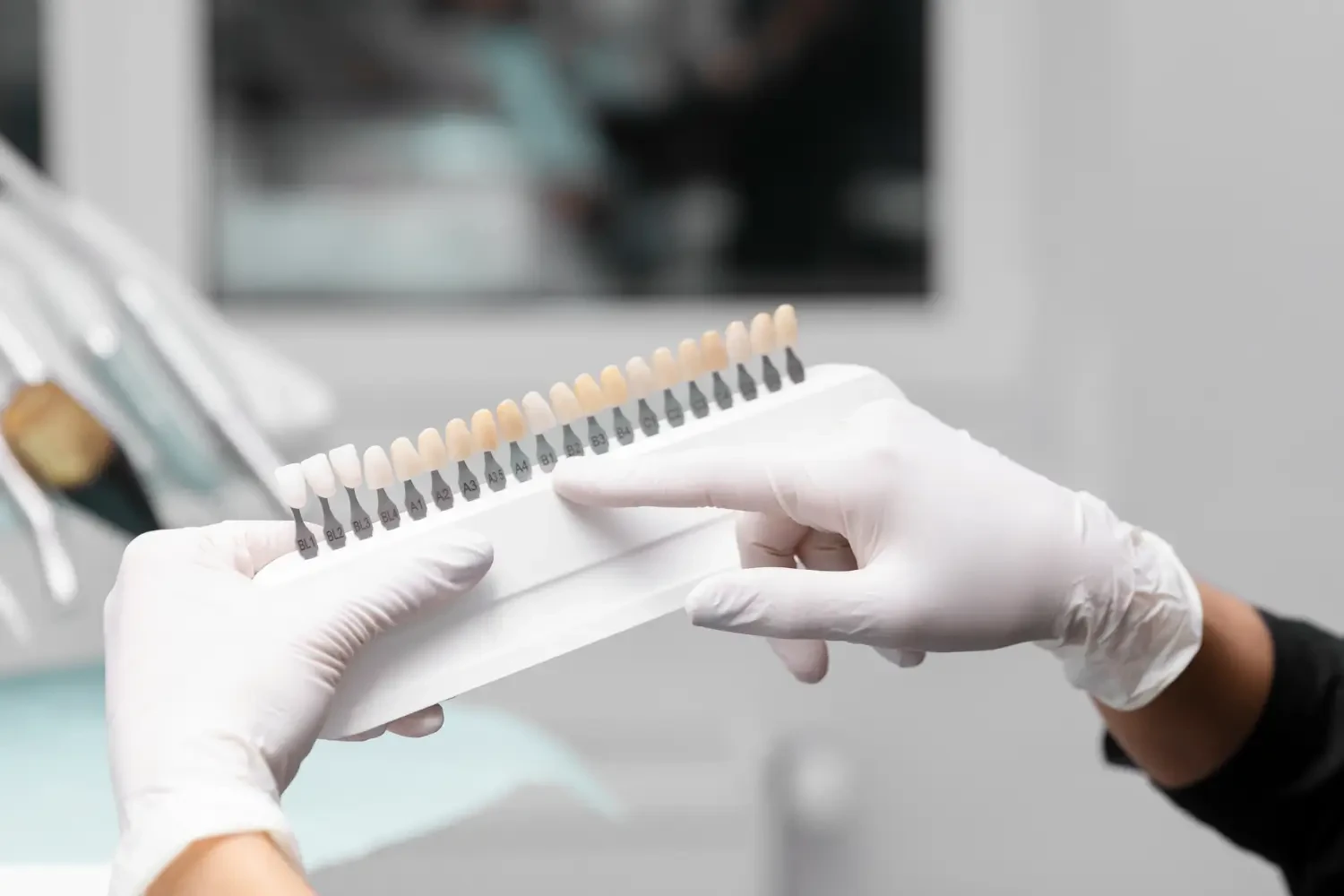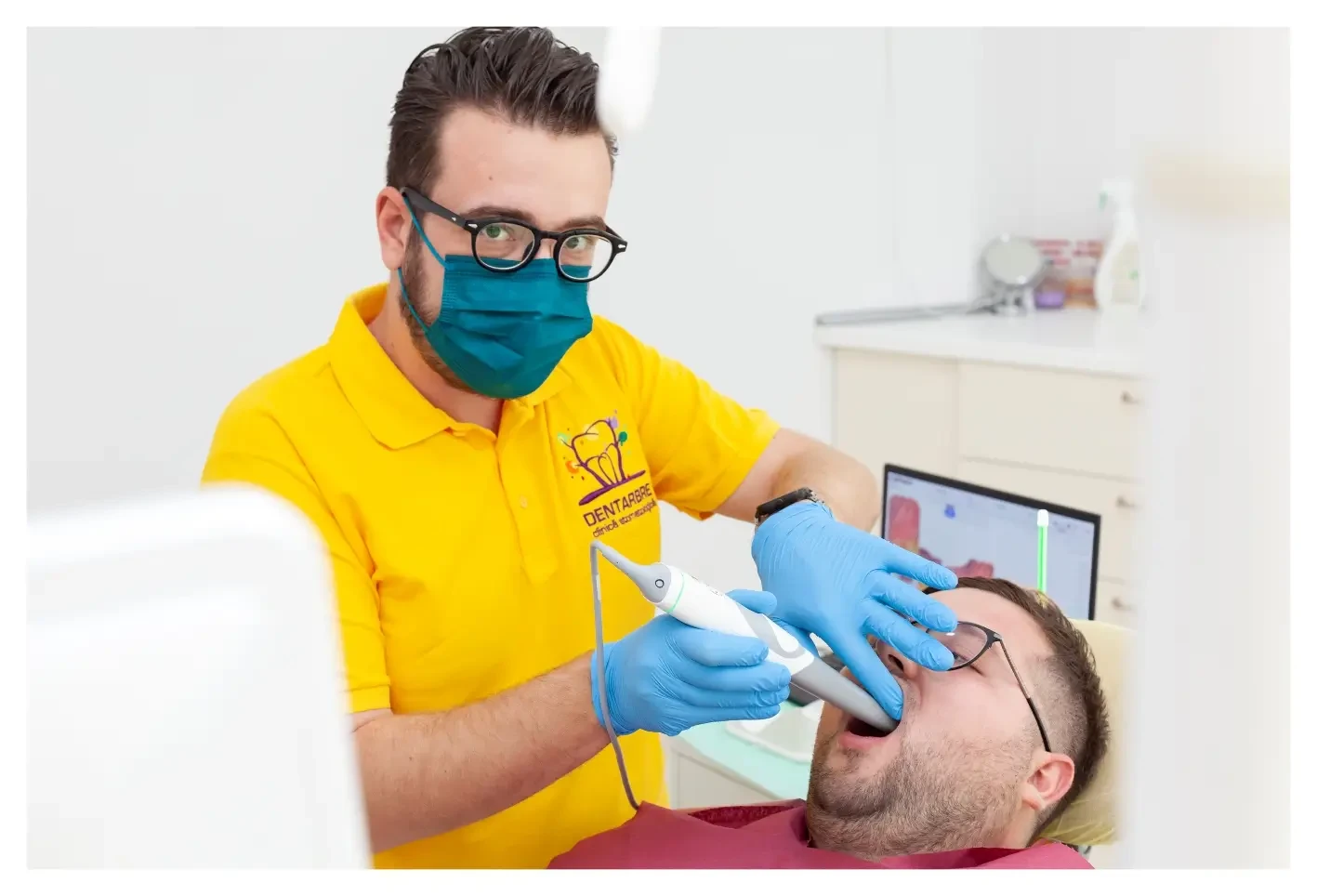Dental crowns are used in dentistry to restore the functionality and aesthetics of teeth that have been lost, worn out, affected by caries or damaged as a result of physical trauma. Crowns replace or cover the visible part of the tooth, being placed either on the surface of the existing tooth, in patients with fractures or who have undergone endodontic treatment, or on a dental implant, in patients who have lost the tooth and who have benefited from implantology treatment.
What is a dental crown?
A dental crown is a prosthetic work fixed on top of a natural tooth to restore its shape, size, strength and appearance. The dental crown can also be used with the same degree of success to cover dental implants in patients who have lost one of their natural teeth and who have previously undergone implantology treatment.
When is a dental crown necessary?
There are several reasons why one may opt for a dental crown. One of the most common is the restoration of the tooth affected by caries or excessive wear. Dental crowns can strengthen the structure of the tooth and implicitly prevent the progression of damage. Other situations in which the use of a dental crown is recommended:
- for the restoration of endodontically treated teeth, following the loss of an important dental surface;
- to restore fractured or cracked teeth;
- to correct discoloration or dental imperfections;
- to replace missing teeth (the dental crown can be placed on an implant, to replace the visible part of the tooth).
How much do dental crowns cost?
The cost of a dental crown depends on a number of factors, from the type of technology used in the production of the crown itself to the experience of the medical team. Things that influence the price of a dental crown are:
- the material used in the production of the dental crown (costs may be higher in the case of using zirconium or ceramic dental crowns);
- the complexity of the case and the possible need to carry out additional treatments (for example, the cost may be higher if the previous treatment of a cavity or the insertion of a pivot is required);
- the technology used (crowns made with advanced technologies such as CAD/CAM can be more expensive).
- the technology used for scanning - in the DentArbre clinic, digital scans are performed with an intraoral scanner

Dental crown: price
| Dental services | Price RON |
| Metal-ceramic crown | 900 |
| Full zirconia crown | 1200 |
| Full ceramic crown | 1800 |
| Ceramic crown on Zirconium support | 1600 |
| EMAX crown | 2000 |
| Metal-ceramic crown on INNO implant | 1500 |
| Metal-ceramic crown on Megagen AnyRidge implant | 1500 |
| Zirconium-ceramic crown on the implant | 1700 |
| Temporary crown on the implant | 400 |
| Ablation per crown | 100 |
| Temporary acrylate crown per tooth | 200 |
| Provisional PMMA crown per tooth | 300 |
| Temporary crown Scutan per tooth | 50 |
| Reciment per crown | 150 |
Types of dental crowns according to material
There are several criteria that can be used to classify dental crowns, and the material from which they are made is one of them. The material influences not only the cost of the treatment, but also its effectiveness, the degree of satisfaction and the durability of the crowns over time.
Zirconium dental crown
Zirconium crowns are made of zirconium oxide, an extremely hard and resistant biocompatible ceramic material, which stands out not only for its superior durability, but also for the translucency of the material, which perfectly imitates the appearance of a natural tooth. In addition, treatment with such dental crowns presents an extremely low risk of allergic reactions or gum irritation.
Ceramic dental crown (porcelain)
Ceramic (porcelain) crowns are highly valued for their aesthetics, being frequently used for front teeth. Because they are completely made of ceramic materials, crowns of this type can be more fragile than those made of zirconium, and are not used to cover teeth or implants located in regions of the mouth where chewing forces are excessive.
Composite dental crown
Composite crowns are made from resin-based composite materials that are less durable and less natural-looking than previous options, but at a lower cost. Composite crowns are frequently used as temporary solutions due to their lower durability and susceptibility to wear and discoloration.
Types of dental crowns according to utility
Depending on the clinical needs, dental crowns can be classified according to the degree of coverage (partial or total) and their purpose (temporary or definitive).
Provisional crowns
Provisional crowns are temporary restorations used to protect the tooth until the final crown is made. Made of less durable materials such as acrylate or composite resin, temporary crowns are important for maintaining short-term dental aesthetics and functionality. They also help protect the gums and structure of the restored tooth, preventing sensitivity and further damage.
Definitive crowns
Definitive crowns are long-lasting restorations made of durable and esthetic materials, designed to withstand daily wear and tear and restore the natural appearance of the tooth. The list of definitive crowns includes:
- fully ceramic crowns;
- zirconium crown;
- metal-ceramic crowns (presents a metal core and a ceramic outer layer);
- metal crowns (completely made of metal).
What is the difference between the dental crown used for dental restoration and the one on the implant?
Dental crowns in the usual sense of the word need a tooth as a base (healthy or properly treated, with stable roots), while implant crowns replace an already missing tooth. The crown on the implant is the optimal solution after tooth extractions or trauma accompanied by tooth loss. Although the process of creating such dental work is not a simple one, the crown on the implant solves and prevents many problems, being the only long-term solution that really deserves an investment.
How do we choose the type of crown according to the needs?
The location of the tooth in the oral cavity, the aesthetic and functional needs and the remaining dental structure are factors that determine the type of crown suitable for each case.

Dental crown front teeth (frontal)
In the case of the front teeth, visible during the smile and involved to a lesser extent in the masticatory process, the most recommended material is full porcelain or full ceramic, due to its superior ability to imitate the natural appearance of the tooth. Ceramic dental crowns have a high degree of translucency, similar to natural enamel, so their use allows obtaining a high-quality aesthetic result. Zirconium crowns, also layered with ceramic, can be used to restore front teeth.
Lateral tooth crowns
For the lateral teeth, where the masticatory forces are greater, it is recommended to use crowns made of metal-ceramic or full zirconium crowns. Both types of crowns are very strong and can withstand high forces without fracturing. Zirconium is also an option for lateral teeth due to its strength and high biocompatibility.
Advantages and disadvantages of dental crowns
Dental crowns help extend the life of natural teeth, which is especially important for teeth that are already partially destroyed or weakened. By protecting the teeth from further damage, crowns help maintain the structural integrity of the teeth and allow them to function normally in the chewing process.
Other advantages of dental crowns:
- improvement of masticatory function (teeth that are restored with crowns can respond to masticatory tasks as effectively as natural teeth, thus preventing the discomfort and functional difficulties that could occur in their absence);
- improving the appearance of the teeth (crowns have the ability to improve the appearance of affected teeth, making them look more uniform and natural);
- long-term durability (properly cared for, dental crowns last up to 10 years and look just as good. years).
Like other dental treatments, but not only, dental crowns also have some disadvantages. Tooth sensitivity, a potential consequence of removing a significant amount of tooth enamel, and their susceptibility to fracture (a feature of only certain types of crowns) are the main disadvantages. In rare cases, crowns can cause allergic reactions. The disadvantages are significantly lower than the benefits, the treatment with dental crowns being almost always a safe solution and recommended by dentists.
Stages of treatment with dental crowns
The way the dental procedure is carried out differs depending on the method used. In other words, the procedure can be traditional (involving a classic impression and several visits to the dentist) or modern through intraoral digital scanning that allows the crown to be made in a much shorter time.
In the traditional procedure, the initial stage involves a detailed evaluation of the teeth by the dentist (to determine the need for the dental crown and its type), followed by an impression of the teeth to create the actual crown. In the next phase, the doctor can make adjustments to the tooth to be covered by the crown, removing some of the tooth enamel to prepare the surface for the dental crown.
After the tooth is prepared, a temporary dental crown is applied, which protects the processed tooth structure and allows the patient to function normally until the permanent crown is completed. The impression taken is sent to a dental laboratory, which produces the permanent crown. The manufacturing process of the definitive crown takes several weeks, during which the provisional crown is maintained on the surface of the tooth or implant.
At the second visit, the dentist removes the temporary crown and adapts the permanent crown. After checking the adjustments, the crown is permanently cemented on the tooth, which confirms the end of the treatment.
The modern procedure involves the use of advanced digital technology to reduce the number of visits required. In such an approach, the dentist performs a digital scan of the teeth, and the images obtained are used to build the dental crown. The process includes creating and customizing the crown using CAD/CAM equipment, which allows the crown to be made in a very short time frame. After the crown is completed, it is tested for fit and if everything is in order, it is cemented to the tooth.


Dr. Ciprian Calciu answers questions:
+40787877799 | +40762573398
contact@dentarbre.comȘoseaua Colentina, nr. 16, Bl. A1, Complex Rose Garden, Sector 2, Zona Obor - Colentina - Doamna Ghica
